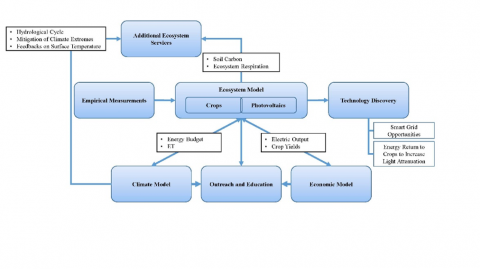You are here
Agrivoltaics: Crop Production and Solar Panels on the Same Land (In Progress)
Recent Project Updates
-
12/10/2024The Energy Team met on Tuesday, Dec. 10th, from 3:30 - 4:30 PM. We reviewed the occupant engagement program’s progress, discussed final steps for solar rooftop project proposals, and provided updates on energy efficiency recommendations. A...
-
11/2/2023Dear Team, Kindly verify the attached document from Ryan to ensure it meets the requirements for a bid posting. We've initiated an inquiry about a potential sole source option, and we're awaiting a response. Regarding the meeting scheduled...
Project Family
-
iSEE Campus as a Living Lab (CALL) Projects
- Adaptive Aluminum Tensegrity Structure as a Bike Parking Canopy
- Addressing Community Health Disparities from Hazardous Waste
- Agrivoltaics: Crop Production and Solar Panels on the Same Land
- City Traffic as a Reservoir System
- Creating Adaptable Autonomous Systems for Energy-Efficient Buildings
- Environment-Enhancing Food, Energy, and Water Systems
- Faculty/Staff Crowdsourced Community Program
- Geothermal: Thermo-Hydraulic Properties of Glacial Tills
- I-PLACES Living Laboratory
- Integrating Groundwater Resources and Geothermal Energy for Water-Energy Security and Resilience
- Student Mobility on and around the Illinois campus
- Testing Geopolymer Performance in a Geothermal Exchange System
- Thermochemical Batteries: Turning Waste Heat into an Energy Source
- Towards Zero Waste: Automated Waste Classification via Computer Vision
- Wind Turbine/Pavilion Integration for Electricity Generation
Associated Collections
Description
Global demand for food, energy, and water is increasing, which poses the challenge of how to meet these demands in an environmentally and economically sustainable way. At present, energy production is dominated by carbon-intensive fossil fuels; however, renewable energies are being integrated into the energy sector at an increasing rate. Bioenergy crops reduce dependence on fossil fuels, but the efficiency of crops converting sunlight to stored energy is low — and the water requirements from agronomic and industrial perspectives is high.
This study, supported by iSEE’s proposal development team, investigates a strategy called agrivoltaics, by which crop production and photovoltaics can be merged within a landscape to increase the total energy output toward food and energy production and to do so with less water and in an ecologically and environmentally sustainable manner.
Purpose of the work: Campus Connection
Agrivoltaics can increase the food and energy output per land area while reducing demands for water, based on the ability of solar panels to alter the plant growth environment to increase landscape water use efficiency (WUE) while marginally decreasing crop production but significantly increasing renewable fuel production relative to existing land use.
The Agrivoltaics Team, initiated by iSEE in 2018 — proposes to integrate economic models with an ecosystem model altered to include an agrivoltaic ecosystem. These coupled models will be used to investigate the energy output per land area and impacts on water use and water quality, and to spatially analyze agrivoltaics relative to the current ecosystem across the Midwestern U.S. Additionally, we will address social acceptance and create an outreach plan using the most effective strategies to promote K-12 interest in challenges facing the interface of food, energy, and water resources.
The proposed site for an agrivoltaics study would be the 21-acre Illinois Solar Farm, along the south side of Windsor Road between First Street and the railroad tracks. The Farm, which went online in late Fall 2015, is expected to produce an estimated 7.86 million kilowatt-hours (kWh) annually, or approximately 2% of the FY15 electrical demand for the Urbana campus making this site one of the largest university solar arrays in the country. Research estimates the Solar Farm will generate up to 91% of its original output even in Year 20 of the project.
Solar Farm 2.0 is also expected to be built in the near future on the U of I campus, lending further land for an agrivoltaics study.
Project Team
-
Project Leader:
Madhu Khanna, Professor, Agricultural and Consumer EconomicsTeam Members:
- Carl Bernacchi, USDA ARS Adjunct Professor, Plant Biology
- Bruce Branham, Professor, Crop Sciences
- Evan H. DeLucia, Professor, Plant Biology
- Kaiyu Guan, Assistant Professor, Natural Resources and Environmental Sciences
- Praveen Kumar, Professor, Civil and Environmental Engineering
- H. Chad Lane, Associate Professor, Educational Psychology
- Nenad Miljkovic, Assistant Professor, Mechanical Science and Engineering
- Nuria Gomez-Casanovas, Visiting Research Specialist, iSEE
- Bin Peng, Postdoctoral Research Associate, National Center for Supercomputing Applications
Themes
-
Primary Theme:
Other Themes:

